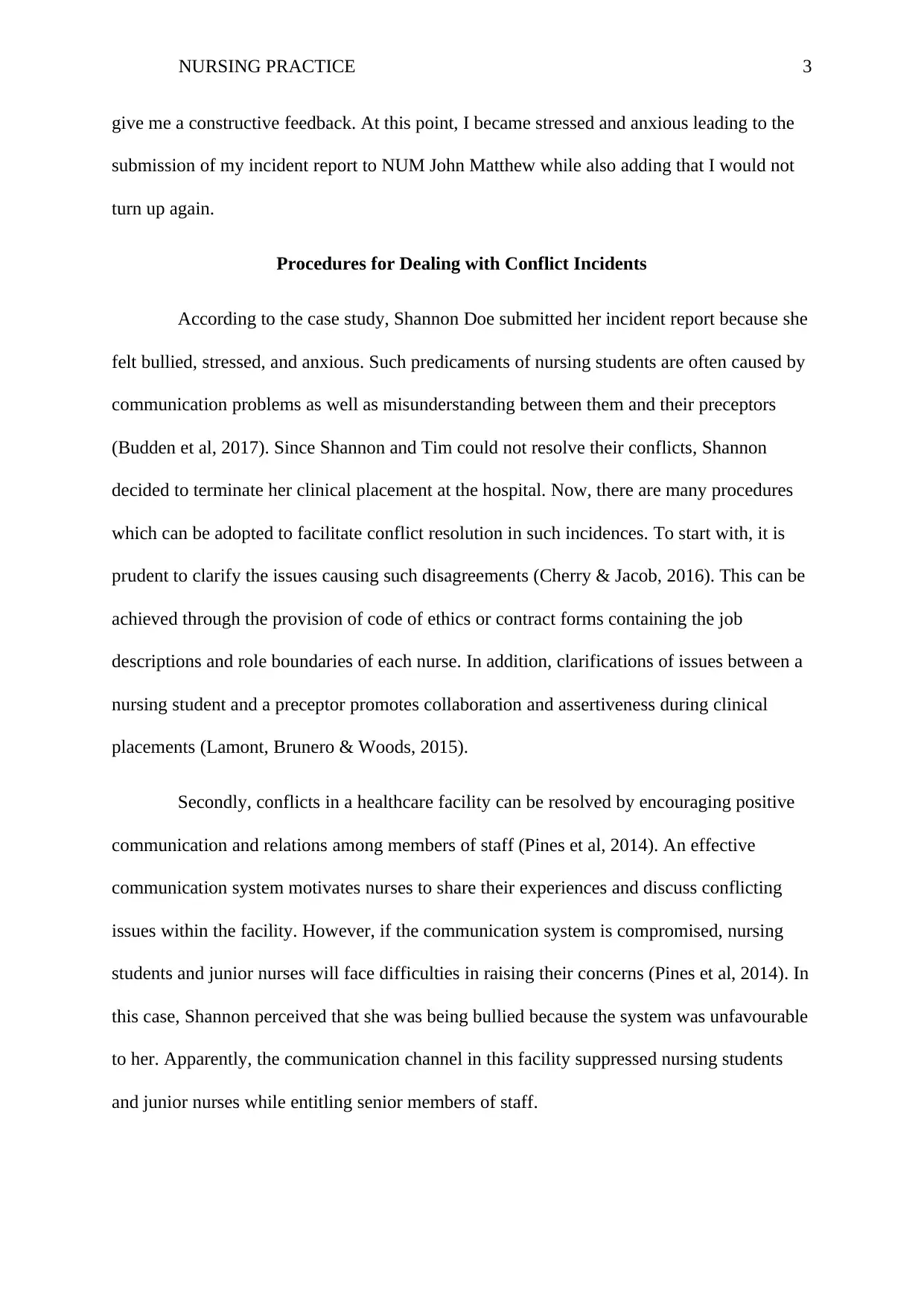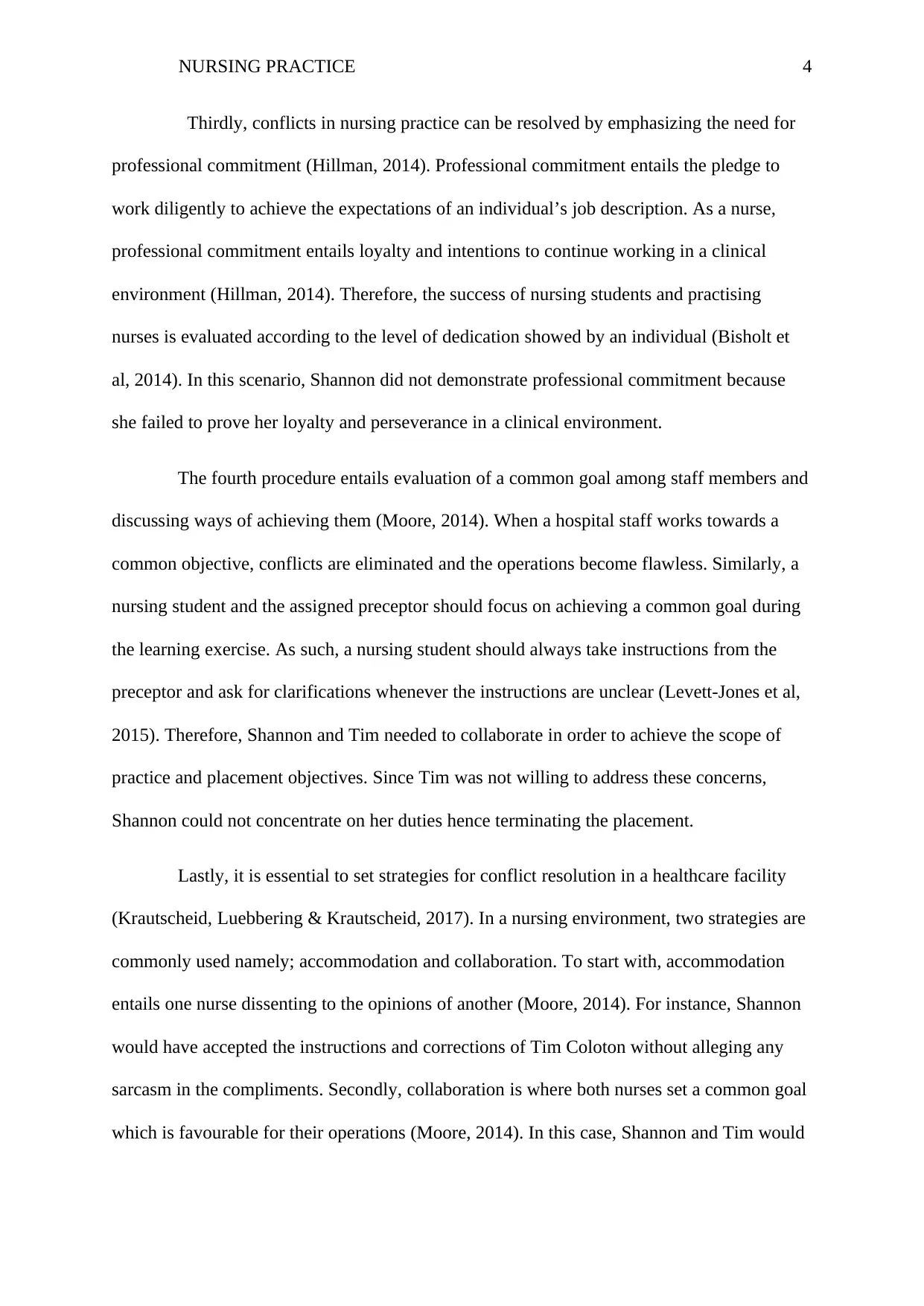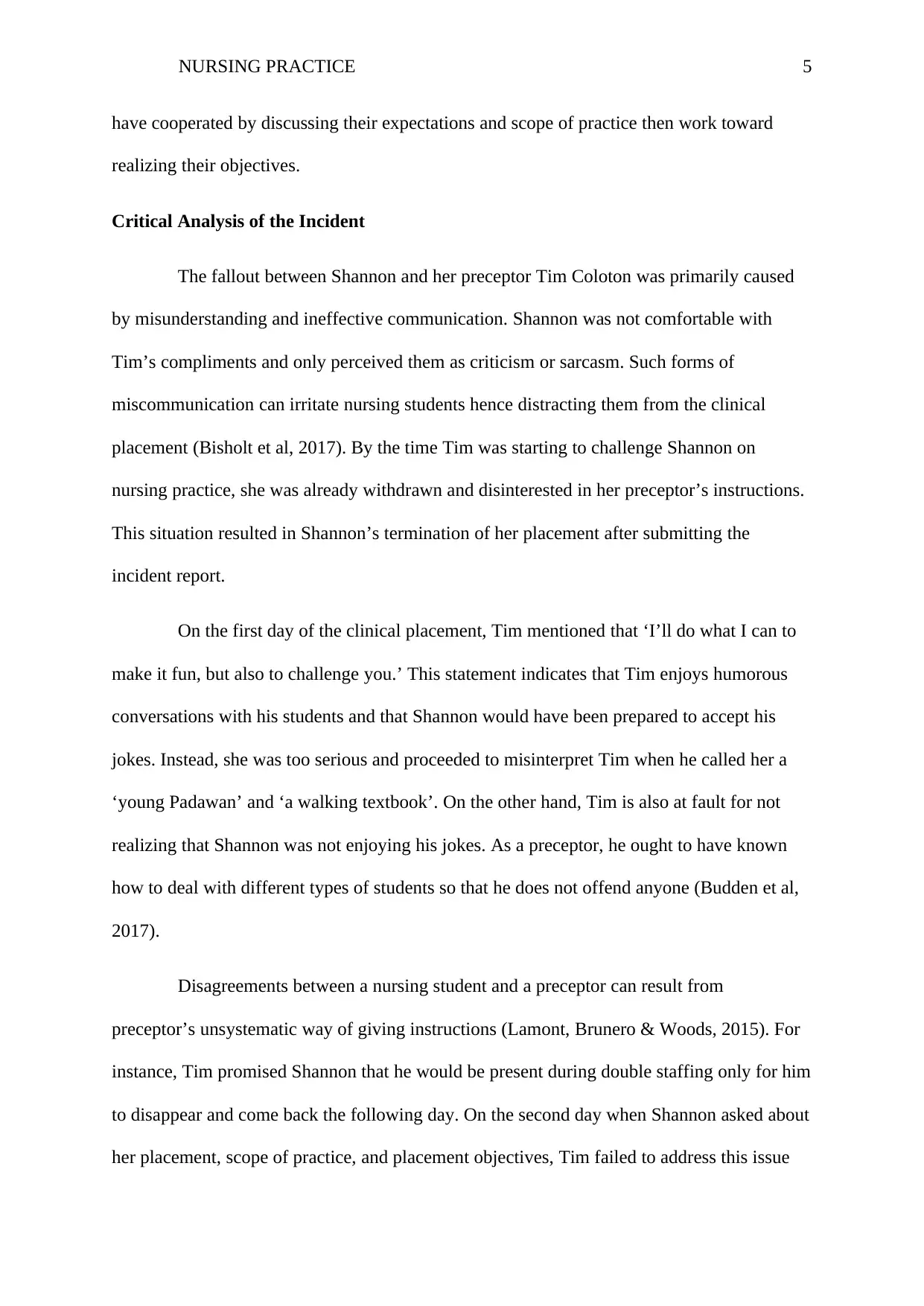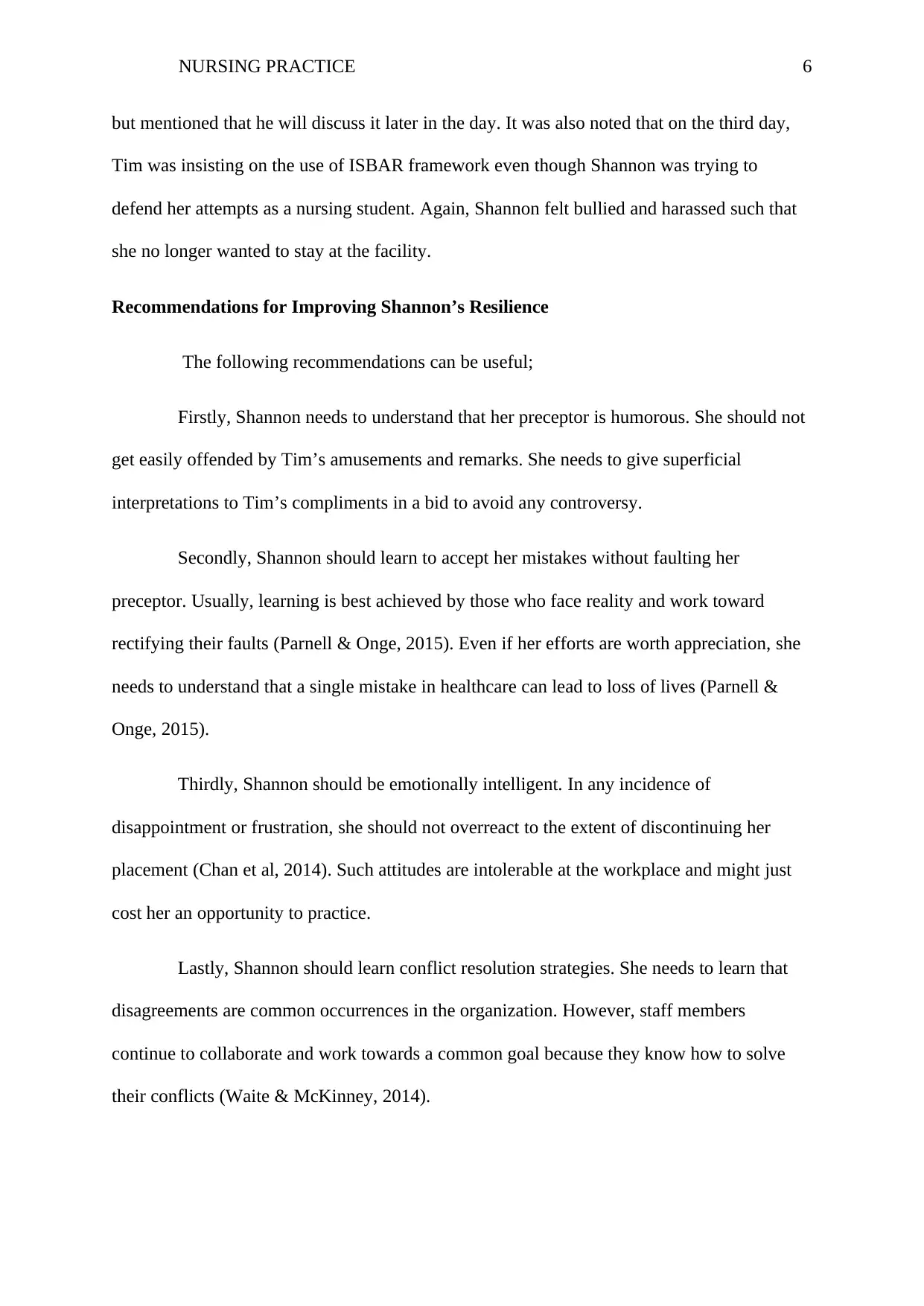Charles Darwin University: Nursing Practice Incident Report Analysis
VerifiedAdded on 2022/12/23
|8
|2211
|3
Case Study
AI Summary
This case study analyzes a nursing incident report filed by Shannon Doe, a third-year undergraduate nurse on clinical placement at Charles Darwin University Hospital. The report details a conflict with her preceptor, RN Tim Coloton, stemming from miscommunication and differing perceptions of his feedback. The assignment explores the procedures for dealing with conflict incidents, including clarifying issues, encouraging positive communication, emphasizing professional commitment, evaluating common goals, and setting strategies for conflict resolution. A critical analysis of the incident reveals that Shannon felt bullied and misunderstood Tim's communication style. The document then provides recommendations for improving Shannon's resilience, such as understanding her preceptor's humor, accepting mistakes, developing emotional intelligence, and learning conflict resolution strategies. The assignment concludes with a list of references supporting the analysis and recommendations.

Running Head: NURSING PRACTICE 1
Nursing Practice
Name of Student
Name of Institution
Date of Submission
Nursing Practice
Name of Student
Name of Institution
Date of Submission
Paraphrase This Document
Need a fresh take? Get an instant paraphrase of this document with our AI Paraphraser

NURSING PRACTICE 2
Nursing Practice
Incident Report
On Monday, I arrived at Charles Darwin University Hospital Medical Ward to
undertake my clinical placement for 2 weeks. I was received by RN Tim Coloton who
introduced himself as my preceptor and guided me through my orientation. After
familiarizing myself with this facility, I was expecting Tim Coloton to give me further
instructions but I did not see him again that day.
On Tuesday, I reported at the facility and met Tim Coloton who explained why he
could not appear in double staffing. I requested him that I wanted to discuss issues about my
placement, scope of practice, and placement objectives. Instead, Tim Coloton replied that he
would create time much later for that discussion. While there, Tim Coloton referred to me as
a ‘young Padawan’. I felt that my preceptor was undermining my practice. Later that day, we
were doing ward rounds in the assigned rooms 1 to 5 when we met a 21-year-old woman with
leukaemia in room 1. Tim Coloton challenged me to describe where I should look for
bleeding in that patient. After describing the procedure, Tim Coloton referred to me as a
walking textbook. This compliment did not auger well with my intuition because I felt like
my preceptor was becoming sarcastic.
On the third day, I completed my morning shift and Tim Coloton asked me to
handover my patients to the afternoon staff RN Jenny Lee, RN Elizabeth McGregor, and EN
Dorothy Mac. Unfortunately, I forgot to mention that patient Ross Kantilla was on a 1000ml
fluid restriction while patient Margarita Voulos was to fast from midnight Wednesday until
morning. Tim noted my mistakes and called me aside. He instructed me to adhere to the
ISBAR framework whenever handing over my patients. I told Tim that he was too picky for
summoning me over the two omissions. However, Tim affirmed that he was only trying to
Nursing Practice
Incident Report
On Monday, I arrived at Charles Darwin University Hospital Medical Ward to
undertake my clinical placement for 2 weeks. I was received by RN Tim Coloton who
introduced himself as my preceptor and guided me through my orientation. After
familiarizing myself with this facility, I was expecting Tim Coloton to give me further
instructions but I did not see him again that day.
On Tuesday, I reported at the facility and met Tim Coloton who explained why he
could not appear in double staffing. I requested him that I wanted to discuss issues about my
placement, scope of practice, and placement objectives. Instead, Tim Coloton replied that he
would create time much later for that discussion. While there, Tim Coloton referred to me as
a ‘young Padawan’. I felt that my preceptor was undermining my practice. Later that day, we
were doing ward rounds in the assigned rooms 1 to 5 when we met a 21-year-old woman with
leukaemia in room 1. Tim Coloton challenged me to describe where I should look for
bleeding in that patient. After describing the procedure, Tim Coloton referred to me as a
walking textbook. This compliment did not auger well with my intuition because I felt like
my preceptor was becoming sarcastic.
On the third day, I completed my morning shift and Tim Coloton asked me to
handover my patients to the afternoon staff RN Jenny Lee, RN Elizabeth McGregor, and EN
Dorothy Mac. Unfortunately, I forgot to mention that patient Ross Kantilla was on a 1000ml
fluid restriction while patient Margarita Voulos was to fast from midnight Wednesday until
morning. Tim noted my mistakes and called me aside. He instructed me to adhere to the
ISBAR framework whenever handing over my patients. I told Tim that he was too picky for
summoning me over the two omissions. However, Tim affirmed that he was only trying to

NURSING PRACTICE 3
give me a constructive feedback. At this point, I became stressed and anxious leading to the
submission of my incident report to NUM John Matthew while also adding that I would not
turn up again.
Procedures for Dealing with Conflict Incidents
According to the case study, Shannon Doe submitted her incident report because she
felt bullied, stressed, and anxious. Such predicaments of nursing students are often caused by
communication problems as well as misunderstanding between them and their preceptors
(Budden et al, 2017). Since Shannon and Tim could not resolve their conflicts, Shannon
decided to terminate her clinical placement at the hospital. Now, there are many procedures
which can be adopted to facilitate conflict resolution in such incidences. To start with, it is
prudent to clarify the issues causing such disagreements (Cherry & Jacob, 2016). This can be
achieved through the provision of code of ethics or contract forms containing the job
descriptions and role boundaries of each nurse. In addition, clarifications of issues between a
nursing student and a preceptor promotes collaboration and assertiveness during clinical
placements (Lamont, Brunero & Woods, 2015).
Secondly, conflicts in a healthcare facility can be resolved by encouraging positive
communication and relations among members of staff (Pines et al, 2014). An effective
communication system motivates nurses to share their experiences and discuss conflicting
issues within the facility. However, if the communication system is compromised, nursing
students and junior nurses will face difficulties in raising their concerns (Pines et al, 2014). In
this case, Shannon perceived that she was being bullied because the system was unfavourable
to her. Apparently, the communication channel in this facility suppressed nursing students
and junior nurses while entitling senior members of staff.
give me a constructive feedback. At this point, I became stressed and anxious leading to the
submission of my incident report to NUM John Matthew while also adding that I would not
turn up again.
Procedures for Dealing with Conflict Incidents
According to the case study, Shannon Doe submitted her incident report because she
felt bullied, stressed, and anxious. Such predicaments of nursing students are often caused by
communication problems as well as misunderstanding between them and their preceptors
(Budden et al, 2017). Since Shannon and Tim could not resolve their conflicts, Shannon
decided to terminate her clinical placement at the hospital. Now, there are many procedures
which can be adopted to facilitate conflict resolution in such incidences. To start with, it is
prudent to clarify the issues causing such disagreements (Cherry & Jacob, 2016). This can be
achieved through the provision of code of ethics or contract forms containing the job
descriptions and role boundaries of each nurse. In addition, clarifications of issues between a
nursing student and a preceptor promotes collaboration and assertiveness during clinical
placements (Lamont, Brunero & Woods, 2015).
Secondly, conflicts in a healthcare facility can be resolved by encouraging positive
communication and relations among members of staff (Pines et al, 2014). An effective
communication system motivates nurses to share their experiences and discuss conflicting
issues within the facility. However, if the communication system is compromised, nursing
students and junior nurses will face difficulties in raising their concerns (Pines et al, 2014). In
this case, Shannon perceived that she was being bullied because the system was unfavourable
to her. Apparently, the communication channel in this facility suppressed nursing students
and junior nurses while entitling senior members of staff.
⊘ This is a preview!⊘
Do you want full access?
Subscribe today to unlock all pages.

Trusted by 1+ million students worldwide

NURSING PRACTICE 4
Thirdly, conflicts in nursing practice can be resolved by emphasizing the need for
professional commitment (Hillman, 2014). Professional commitment entails the pledge to
work diligently to achieve the expectations of an individual’s job description. As a nurse,
professional commitment entails loyalty and intentions to continue working in a clinical
environment (Hillman, 2014). Therefore, the success of nursing students and practising
nurses is evaluated according to the level of dedication showed by an individual (Bisholt et
al, 2014). In this scenario, Shannon did not demonstrate professional commitment because
she failed to prove her loyalty and perseverance in a clinical environment.
The fourth procedure entails evaluation of a common goal among staff members and
discussing ways of achieving them (Moore, 2014). When a hospital staff works towards a
common objective, conflicts are eliminated and the operations become flawless. Similarly, a
nursing student and the assigned preceptor should focus on achieving a common goal during
the learning exercise. As such, a nursing student should always take instructions from the
preceptor and ask for clarifications whenever the instructions are unclear (Levett-Jones et al,
2015). Therefore, Shannon and Tim needed to collaborate in order to achieve the scope of
practice and placement objectives. Since Tim was not willing to address these concerns,
Shannon could not concentrate on her duties hence terminating the placement.
Lastly, it is essential to set strategies for conflict resolution in a healthcare facility
(Krautscheid, Luebbering & Krautscheid, 2017). In a nursing environment, two strategies are
commonly used namely; accommodation and collaboration. To start with, accommodation
entails one nurse dissenting to the opinions of another (Moore, 2014). For instance, Shannon
would have accepted the instructions and corrections of Tim Coloton without alleging any
sarcasm in the compliments. Secondly, collaboration is where both nurses set a common goal
which is favourable for their operations (Moore, 2014). In this case, Shannon and Tim would
Thirdly, conflicts in nursing practice can be resolved by emphasizing the need for
professional commitment (Hillman, 2014). Professional commitment entails the pledge to
work diligently to achieve the expectations of an individual’s job description. As a nurse,
professional commitment entails loyalty and intentions to continue working in a clinical
environment (Hillman, 2014). Therefore, the success of nursing students and practising
nurses is evaluated according to the level of dedication showed by an individual (Bisholt et
al, 2014). In this scenario, Shannon did not demonstrate professional commitment because
she failed to prove her loyalty and perseverance in a clinical environment.
The fourth procedure entails evaluation of a common goal among staff members and
discussing ways of achieving them (Moore, 2014). When a hospital staff works towards a
common objective, conflicts are eliminated and the operations become flawless. Similarly, a
nursing student and the assigned preceptor should focus on achieving a common goal during
the learning exercise. As such, a nursing student should always take instructions from the
preceptor and ask for clarifications whenever the instructions are unclear (Levett-Jones et al,
2015). Therefore, Shannon and Tim needed to collaborate in order to achieve the scope of
practice and placement objectives. Since Tim was not willing to address these concerns,
Shannon could not concentrate on her duties hence terminating the placement.
Lastly, it is essential to set strategies for conflict resolution in a healthcare facility
(Krautscheid, Luebbering & Krautscheid, 2017). In a nursing environment, two strategies are
commonly used namely; accommodation and collaboration. To start with, accommodation
entails one nurse dissenting to the opinions of another (Moore, 2014). For instance, Shannon
would have accepted the instructions and corrections of Tim Coloton without alleging any
sarcasm in the compliments. Secondly, collaboration is where both nurses set a common goal
which is favourable for their operations (Moore, 2014). In this case, Shannon and Tim would
Paraphrase This Document
Need a fresh take? Get an instant paraphrase of this document with our AI Paraphraser

NURSING PRACTICE 5
have cooperated by discussing their expectations and scope of practice then work toward
realizing their objectives.
Critical Analysis of the Incident
The fallout between Shannon and her preceptor Tim Coloton was primarily caused
by misunderstanding and ineffective communication. Shannon was not comfortable with
Tim’s compliments and only perceived them as criticism or sarcasm. Such forms of
miscommunication can irritate nursing students hence distracting them from the clinical
placement (Bisholt et al, 2017). By the time Tim was starting to challenge Shannon on
nursing practice, she was already withdrawn and disinterested in her preceptor’s instructions.
This situation resulted in Shannon’s termination of her placement after submitting the
incident report.
On the first day of the clinical placement, Tim mentioned that ‘I’ll do what I can to
make it fun, but also to challenge you.’ This statement indicates that Tim enjoys humorous
conversations with his students and that Shannon would have been prepared to accept his
jokes. Instead, she was too serious and proceeded to misinterpret Tim when he called her a
‘young Padawan’ and ‘a walking textbook’. On the other hand, Tim is also at fault for not
realizing that Shannon was not enjoying his jokes. As a preceptor, he ought to have known
how to deal with different types of students so that he does not offend anyone (Budden et al,
2017).
Disagreements between a nursing student and a preceptor can result from
preceptor’s unsystematic way of giving instructions (Lamont, Brunero & Woods, 2015). For
instance, Tim promised Shannon that he would be present during double staffing only for him
to disappear and come back the following day. On the second day when Shannon asked about
her placement, scope of practice, and placement objectives, Tim failed to address this issue
have cooperated by discussing their expectations and scope of practice then work toward
realizing their objectives.
Critical Analysis of the Incident
The fallout between Shannon and her preceptor Tim Coloton was primarily caused
by misunderstanding and ineffective communication. Shannon was not comfortable with
Tim’s compliments and only perceived them as criticism or sarcasm. Such forms of
miscommunication can irritate nursing students hence distracting them from the clinical
placement (Bisholt et al, 2017). By the time Tim was starting to challenge Shannon on
nursing practice, she was already withdrawn and disinterested in her preceptor’s instructions.
This situation resulted in Shannon’s termination of her placement after submitting the
incident report.
On the first day of the clinical placement, Tim mentioned that ‘I’ll do what I can to
make it fun, but also to challenge you.’ This statement indicates that Tim enjoys humorous
conversations with his students and that Shannon would have been prepared to accept his
jokes. Instead, she was too serious and proceeded to misinterpret Tim when he called her a
‘young Padawan’ and ‘a walking textbook’. On the other hand, Tim is also at fault for not
realizing that Shannon was not enjoying his jokes. As a preceptor, he ought to have known
how to deal with different types of students so that he does not offend anyone (Budden et al,
2017).
Disagreements between a nursing student and a preceptor can result from
preceptor’s unsystematic way of giving instructions (Lamont, Brunero & Woods, 2015). For
instance, Tim promised Shannon that he would be present during double staffing only for him
to disappear and come back the following day. On the second day when Shannon asked about
her placement, scope of practice, and placement objectives, Tim failed to address this issue

NURSING PRACTICE 6
but mentioned that he will discuss it later in the day. It was also noted that on the third day,
Tim was insisting on the use of ISBAR framework even though Shannon was trying to
defend her attempts as a nursing student. Again, Shannon felt bullied and harassed such that
she no longer wanted to stay at the facility.
Recommendations for Improving Shannon’s Resilience
The following recommendations can be useful;
Firstly, Shannon needs to understand that her preceptor is humorous. She should not
get easily offended by Tim’s amusements and remarks. She needs to give superficial
interpretations to Tim’s compliments in a bid to avoid any controversy.
Secondly, Shannon should learn to accept her mistakes without faulting her
preceptor. Usually, learning is best achieved by those who face reality and work toward
rectifying their faults (Parnell & Onge, 2015). Even if her efforts are worth appreciation, she
needs to understand that a single mistake in healthcare can lead to loss of lives (Parnell &
Onge, 2015).
Thirdly, Shannon should be emotionally intelligent. In any incidence of
disappointment or frustration, she should not overreact to the extent of discontinuing her
placement (Chan et al, 2014). Such attitudes are intolerable at the workplace and might just
cost her an opportunity to practice.
Lastly, Shannon should learn conflict resolution strategies. She needs to learn that
disagreements are common occurrences in the organization. However, staff members
continue to collaborate and work towards a common goal because they know how to solve
their conflicts (Waite & McKinney, 2014).
but mentioned that he will discuss it later in the day. It was also noted that on the third day,
Tim was insisting on the use of ISBAR framework even though Shannon was trying to
defend her attempts as a nursing student. Again, Shannon felt bullied and harassed such that
she no longer wanted to stay at the facility.
Recommendations for Improving Shannon’s Resilience
The following recommendations can be useful;
Firstly, Shannon needs to understand that her preceptor is humorous. She should not
get easily offended by Tim’s amusements and remarks. She needs to give superficial
interpretations to Tim’s compliments in a bid to avoid any controversy.
Secondly, Shannon should learn to accept her mistakes without faulting her
preceptor. Usually, learning is best achieved by those who face reality and work toward
rectifying their faults (Parnell & Onge, 2015). Even if her efforts are worth appreciation, she
needs to understand that a single mistake in healthcare can lead to loss of lives (Parnell &
Onge, 2015).
Thirdly, Shannon should be emotionally intelligent. In any incidence of
disappointment or frustration, she should not overreact to the extent of discontinuing her
placement (Chan et al, 2014). Such attitudes are intolerable at the workplace and might just
cost her an opportunity to practice.
Lastly, Shannon should learn conflict resolution strategies. She needs to learn that
disagreements are common occurrences in the organization. However, staff members
continue to collaborate and work towards a common goal because they know how to solve
their conflicts (Waite & McKinney, 2014).
⊘ This is a preview!⊘
Do you want full access?
Subscribe today to unlock all pages.

Trusted by 1+ million students worldwide

NURSING PRACTICE 7
References
Bisholt, B., Ohlsson, U., Engström, A. K., Johansson, A. S., & Gustafsson, M. (2014).
Nursing students' assessment of the learning environment in different clinical
settings. Nurse education in practice, 14(3), 304-310.
Budden, L. M., Birks, M., Cant, R., Bagley, T., & Park, T. (2017). Australian nursing
students’ experience of bullying and/or harassment during clinical placement.
Collegian, 24(2), 125-133.
Chan, J. C., Sit, E. N., & Lau, W. M. (2014). Conflict management styles, emotional
intelligence and implicit theories of personality of nursing students: A cross-
sectional study. Nurse education today, 34(6), 934-939.
Cherry, B., & Jacob, S. R. (2016). Contemporary nursing: Issues, trends, & management.
Elsevier Health Sciences.
Hillman, D. R. (2014). Understanding multigenerational work-value conflict resolution.
Journal of Workplace Behavioral Health, 29(3), 240-257.
Krautscheid, L. C., Luebbering, C. M., & Krautscheid, B. A. (2017). Conflict-handling styles
demonstrated by nursing students in response to microethical dilemmas. Nursing
Education Perspectives, 38(3), 143-145.
Lamont, S., Brunero, S., & Woods, K. P. (2015). Satisfaction with clinical placement–the
perspective of nursing students from multiple universities. Collegian, 22(1), 125-
133.
Levett-Jones, T., Pitt, V., Courtney-Pratt, H., Harbrow, G., & Rossiter, R. (2015). What are
the primary concerns of nursing students as they prepare for and contemplate their
first clinical placement experience? Nurse education in practice, 15(4), 304-309.
References
Bisholt, B., Ohlsson, U., Engström, A. K., Johansson, A. S., & Gustafsson, M. (2014).
Nursing students' assessment of the learning environment in different clinical
settings. Nurse education in practice, 14(3), 304-310.
Budden, L. M., Birks, M., Cant, R., Bagley, T., & Park, T. (2017). Australian nursing
students’ experience of bullying and/or harassment during clinical placement.
Collegian, 24(2), 125-133.
Chan, J. C., Sit, E. N., & Lau, W. M. (2014). Conflict management styles, emotional
intelligence and implicit theories of personality of nursing students: A cross-
sectional study. Nurse education today, 34(6), 934-939.
Cherry, B., & Jacob, S. R. (2016). Contemporary nursing: Issues, trends, & management.
Elsevier Health Sciences.
Hillman, D. R. (2014). Understanding multigenerational work-value conflict resolution.
Journal of Workplace Behavioral Health, 29(3), 240-257.
Krautscheid, L. C., Luebbering, C. M., & Krautscheid, B. A. (2017). Conflict-handling styles
demonstrated by nursing students in response to microethical dilemmas. Nursing
Education Perspectives, 38(3), 143-145.
Lamont, S., Brunero, S., & Woods, K. P. (2015). Satisfaction with clinical placement–the
perspective of nursing students from multiple universities. Collegian, 22(1), 125-
133.
Levett-Jones, T., Pitt, V., Courtney-Pratt, H., Harbrow, G., & Rossiter, R. (2015). What are
the primary concerns of nursing students as they prepare for and contemplate their
first clinical placement experience? Nurse education in practice, 15(4), 304-309.
Paraphrase This Document
Need a fresh take? Get an instant paraphrase of this document with our AI Paraphraser

NURSING PRACTICE 8
Moore, C. W. (2014). The mediation process: Practical strategies for resolving conflict. John
Wiley & Sons.
Parnell, R. B., & Onge, J. L. S. (2015). Teaching safety in nursing practice: Is emotional
intelligence a vital component? Teaching and Learning in Nursing, 10(2), 88-92.
Pines, E. W., Rauschhuber, M. L., Cook, J. D., Norgan, G. H., Canchola, L., Richardson, C.,
& Jones, M. E. (2014). Enhancing resilience, empowerment, and conflict
management among baccalaureate students: Outcomes of a pilot study. Nurse
Educator, 39(2), 85-90.
Waite, R., & McKinney, N. S. (2014). Enhancing conflict competency. ABNF Journal, 25(4).
Moore, C. W. (2014). The mediation process: Practical strategies for resolving conflict. John
Wiley & Sons.
Parnell, R. B., & Onge, J. L. S. (2015). Teaching safety in nursing practice: Is emotional
intelligence a vital component? Teaching and Learning in Nursing, 10(2), 88-92.
Pines, E. W., Rauschhuber, M. L., Cook, J. D., Norgan, G. H., Canchola, L., Richardson, C.,
& Jones, M. E. (2014). Enhancing resilience, empowerment, and conflict
management among baccalaureate students: Outcomes of a pilot study. Nurse
Educator, 39(2), 85-90.
Waite, R., & McKinney, N. S. (2014). Enhancing conflict competency. ABNF Journal, 25(4).
1 out of 8
Related Documents
Your All-in-One AI-Powered Toolkit for Academic Success.
+13062052269
info@desklib.com
Available 24*7 on WhatsApp / Email
![[object Object]](/_next/static/media/star-bottom.7253800d.svg)
Unlock your academic potential
Copyright © 2020–2025 A2Z Services. All Rights Reserved. Developed and managed by ZUCOL.





